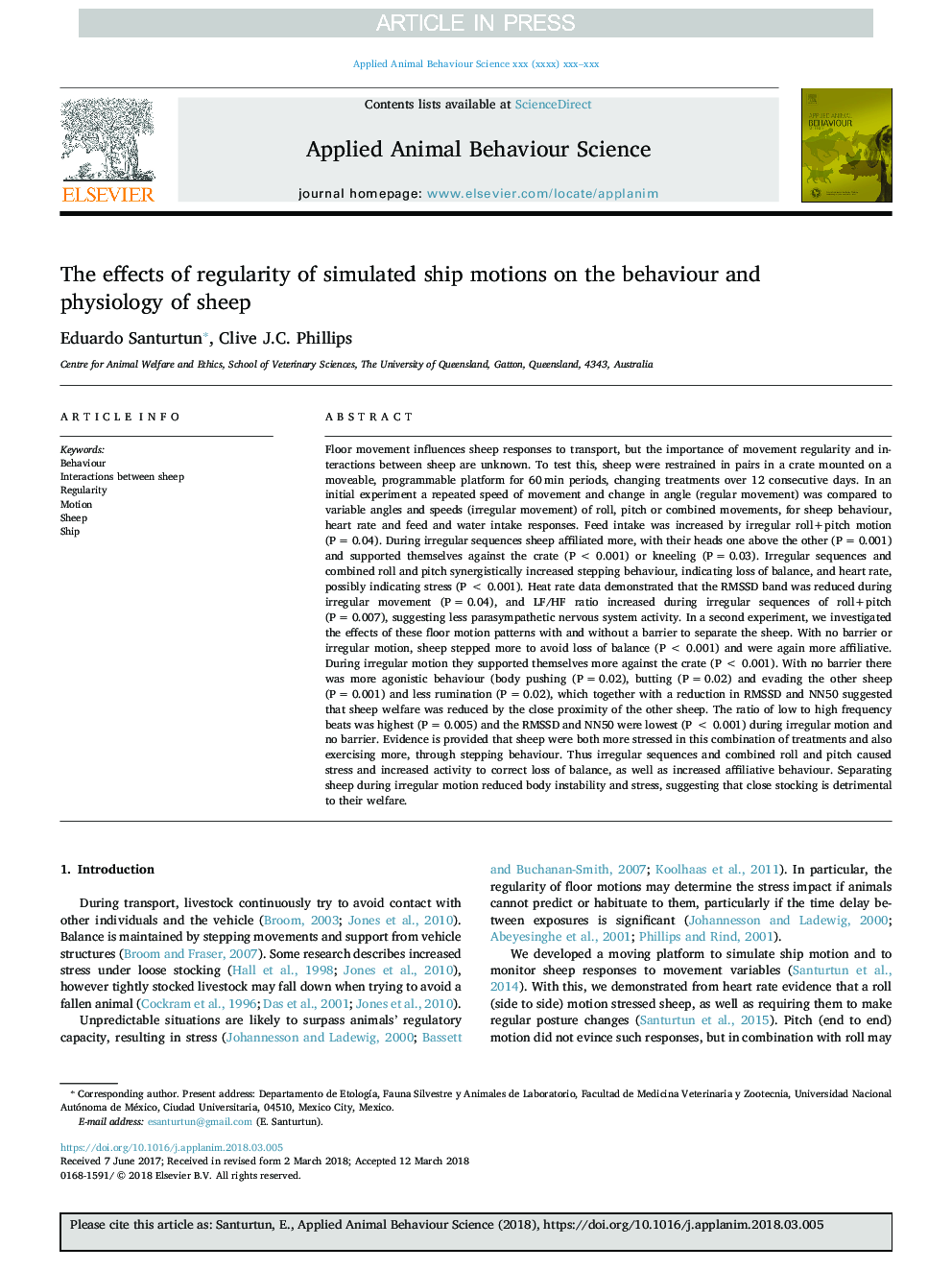| کد مقاله | کد نشریه | سال انتشار | مقاله انگلیسی | نسخه تمام متن |
|---|---|---|---|---|
| 8882752 | 1625302 | 2018 | 10 صفحه PDF | دانلود رایگان |
عنوان انگلیسی مقاله ISI
The effects of regularity of simulated ship motions on the behaviour and physiology of sheep
ترجمه فارسی عنوان
اثرات منظم حرکت حرکات شبیه سازی شده بر رفتار و فیزیولوژی
دانلود مقاله + سفارش ترجمه
دانلود مقاله ISI انگلیسی
رایگان برای ایرانیان
کلمات کلیدی
رفتار - اخلاق، تعاملات میان گوسفند، منظم بودن حرکت گوسفند، کشتی،
موضوعات مرتبط
علوم زیستی و بیوفناوری
علوم کشاورزی و بیولوژیک
علوم دامی و جانورشناسی
چکیده انگلیسی
Floor movement influences sheep responses to transport, but the importance of movement regularity and interactions between sheep are unknown. To test this, sheep were restrained in pairs in a crate mounted on a moveable, programmable platform for 60â¯min periods, changing treatments over 12 consecutive days. In an initial experiment a repeated speed of movement and change in angle (regular movement) was compared to variable angles and speeds (irregular movement) of roll, pitch or combined movements, for sheep behaviour, heart rate and feed and water intake responses. Feed intake was increased by irregular roll+pitch motion (Pâ¯=â¯0.04). During irregular sequences sheep affiliated more, with their heads one above the other (Pâ¯=â¯0.001) and supported themselves against the crate (Pâ¯<â¯0.001) or kneeling (Pâ¯=â¯0.03). Irregular sequences and combined roll and pitch synergistically increased stepping behaviour, indicating loss of balance, and heart rate, possibly indicating stress (Pâ¯<â¯0.001). Heat rate data demonstrated that the RMSSD band was reduced during irregular movement (Pâ¯=â¯0.04), and LF/HF ratio increased during irregular sequences of roll+pitch (Pâ¯=â¯0.007), suggesting less parasympathetic nervous system activity. In a second experiment, we investigated the effects of these floor motion patterns with and without a barrier to separate the sheep. With no barrier or irregular motion, sheep stepped more to avoid loss of balance (Pâ¯<â¯0.001) and were again more affiliative. During irregular motion they supported themselves more against the crate (Pâ¯<â¯0.001). With no barrier there was more agonistic behaviour (body pushing (Pâ¯=â¯0.02), butting (Pâ¯=â¯0.02) and evading the other sheep (Pâ¯=â¯0.001) and less rumination (Pâ¯=â¯0.02), which together with a reduction in RMSSD and NN50 suggested that sheep welfare was reduced by the close proximity of the other sheep. The ratio of low to high frequency beats was highest (Pâ¯=â¯0.005) and the RMSSD and NN50 were lowest (Pâ¯<â¯0.001) during irregular motion and no barrier. Evidence is provided that sheep were both more stressed in this combination of treatments and also exercising more, through stepping behaviour. Thus irregular sequences and combined roll and pitch caused stress and increased activity to correct loss of balance, as well as increased affiliative behaviour. Separating sheep during irregular motion reduced body instability and stress, suggesting that close stocking is detrimental to their welfare.
ناشر
Database: Elsevier - ScienceDirect (ساینس دایرکت)
Journal: Applied Animal Behaviour Science - Volume 204, July 2018, Pages 43-52
Journal: Applied Animal Behaviour Science - Volume 204, July 2018, Pages 43-52
نویسندگان
Eduardo Santurtun, Clive J.C. Phillips,
